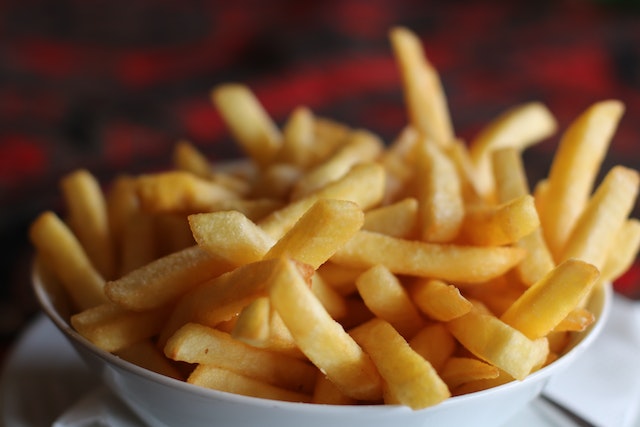
21, Nov 2023
Are Food Should Taste Good Chips Fried?
Have you ever wondered if the chips you are eating are good for you? With so many chips on the market today, knowing which ones are healthy and fried in unhealthy oils can be hard. This article will explore whether food should taste good chips fried.
What Are Fried Chips?
Fried chips are potato chips sliced and then fried in oil to give them their signature crunch and flavourr. The most common oils used for frying chips commercially are vegetable oils like canola, sunflower, corn, or soybean oil.
Chips can be fried at different temperatures, which impacts their nutrition. Low-temperature fried chips are fried at around 300°F, whereas high-temperature fried chips are fried at over 400°F. The higher temperature helps the chips get extra crispy but also causes more oil to be absorbed and more acrylamide formation.
Why Do Fried Chips Taste So Good?
There are a few reasons why fried chips taste so delicious:
The Maillard Reaction
When foods are fried at high temperatures, it causes the sugars and amino acids to react in a process called the Maillard reaction. This reaction produces hundreds offlavourur compounds that give fried foods like chips their iconicsavouryury taste.
Fat Absorption
As chips fry in hot oil, their starch granules absorb fat, which carries a lot of flavor. More fat absorption equals moflavourvour!
Salt and Seasonings
Most chips are seasoned with salt, spices, and otflavouringsrings that complement the fflavourlavour. Common seasonings include salt, paprika, onion powder, garlic powder, vinegar powder, and more.
Crunch Factor
The high frying heat evaporates moisture from the potato slices, giving them a satisfying, crispy texture that we love to bite into.
Are Fried Chips Unhealthy?
Fried chips are often considered unhealthy because they are cooked in oil, which can increase their fat and calorie content. However, some factors impact how healthy or unhealthy fried chips are:
Type of Oil
Chips fried in healthy unsaturated oils like olive or avocado oil are better than those fried in inflammatory oils like soybean and corn.
Frying Temperature
Chips fried at lower temperatures absorb less oil and have reduced acrylamide levels.
Portion Size
Overeating chips can lead to excess calories. Sticking to smaller portions helps control fat and calorie intake.
Ingredients
Some chips have additional unhealthy ingredients like MSG, artifflavourslavors, and preservatives. Check the label for red flags. So, are all fried chips unhealthy? Not necessarily – it depends on the factors above. Moderation is key, along with choosing better quality chips.
Are Baked Chips Healthier Than Fried Chips?
Baked chips are often viewed as a healthier alternative to fried chips. But is this true? Let’s compare baked vs fried chips:
Fat Content
Baked chips have 7-8g fat per 1 oz serving, whereas fried chips have 10-15g fat since no oil is used in baking.
Calories
Baked chips have around 120 calories per ounce compared to 150 calories in fried chips. The calorie difference is because baked chips absorb no oil.
Acrylamide
Acrylamide forms at higher cooking temperatures, so baked chips contain much less than fried varieties.
Nutrients
Baked chips maintain more vitamins and minerals from the potato since they aren’t exposed to high heat.
Flavor
Most people prefeflavourflavor of fried chips over baked versionsflavourslavors have improved in baked chips over the years.
Ingredients
Baked chips typically have fewer artificial ingredients. But check the label as some contain many additives. Baked chips are lower in fat, calories, and acrylamide than fried chips. However, fried chips have a more rflavourflavor.
Tips for Healthier Chips
Here are some tips for choosing healthier chips while still enjoying the crispy, salty snack:
- Go for thicker sliced chips – They absorb less oil during frying.
- Choose chips made with olive, avocado, or coconut oil – They have beneficial fats compared to vegetable oils.
- Pick chips with 2g sat fat or less per serving, indicating less oil absorption.
- Look for chips without artificial flavours, colours, or MSG. – These are signs of overly processed food.
- Opt for chips from vegetables like beet, carrot, or jicama for more nutrients.
- Portion out individual servings rather than eating from a large bag to control portions.
- Pair chips with salsa, guacamole, or hummus, adding nutrients and protein.
Healthy Homemade Oven-Baked Chips
Making baked chips at home is easy and allows you to control the ingredients. Here is a simple recipe:
IngrediThreents:
- 3 medium russet potatoes, sliced into 1/8 inch slices
- 1 tbsp olive oil or avocado oil
- 1/2 tsp sea salt
- 1/2 tsp garlic powder
- 1/2 tsp paprika
Instructions:
- Preheat oven to 400°F. Line a baking sheet with parchment paper.
- Wash and slice potatoes into 1/8-inch slices using a mandoline for uniform thinness. Pat dry thoroughly with paper towels.
- Toss potato slices with oil, salt, garlic powder, and paprika until coated. Spread into a single layer on the baking sheet.
- Bake for 15-18 minutes, flipping once halfway through, until crispy and lightly browned.
- Let chips cool for 5 minutes before serving for optimum crispness. Enjoy!
Homemade baked chips are free of artificial ingredients and pack much more nutrition than store-bought chips. Plus, you can experiment witflavourflavor combinations.
The Bottom Line
While fried chips may taste better to most people, they are higher in fat and calories than baked versions. However, baked chips can also contain unwanted ingredients like artificial flavors. Your healthiest bet is to make your own baked chips at home, where you control the quality of ingredients. But if opting for store-bought chips, go for baked varieties made with minimal ingredients and healthy oils. Overall, it comes down to balance – enjoying chips occasionally as part of an otherwise nutrient-rich diet. With smart choices, you can have and eat your chips!


I do trust all the ideas youve presented in your post They are really convincing and will definitely work Nonetheless the posts are too short for newbies May just you please lengthen them a bit from next time Thank you for the post
Hello everyone, it’s my first visit at this web site, and article
is truly fruitful for me, keep up posting these articles.
Thank you for the auspicious writeup It in fact was a amusement account it Look advanced to far added agreeable from you However how can we communicate